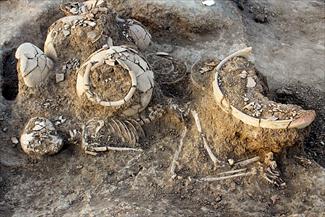Iran Visa: An Iranian-Italian theological team has discovered a graveyard dating back to the Bronze Age, 4,000 years ago, in the aftermath of their explorations in an area known as ‘Chalow’, three km from the town of ‘Sankhast’ in Jajarm County in North Khorasan Province.
After the discovery of the graveyard, the archeologists believe they have encountered a great culture which is known as BMAC (Bactria-Margiana Archaeological Complex) which has previously been reported from northeast of the Iranian plateau.
The Bactria–Margiana Archaeological Complex (BMAC) also known as the Oxus Civilization, is the modern archaeological designation for a Bronze Age civilization of Central Asia, dated to ca. 2300–1700 BCE. It is located in present day northern Afghanistan, eastern Turkmenistan, southern Uzbekistan and western Tajikistan, centered on the upper Amu Darya (Oxus River).

A month ago the joint Irano-Italian team started its second season of archeological excavations in Sankhast, discovering a number of ancient graves dating back to 3700 to 4200 years ago.
It is said that the discovery of the graveyard is a prelude to new studies in Iran’s archeology and history as the discovered works belong to the famous culture of the eastern and northeastern neighbors of Iran known as BMAC or Bactria-Margiana.
Indeed almost in all of the Bronze Age graves discovered in the archaeological site of Chalow the burial-goods are very similar to the BMAC culture.
Ali Akbar Vahdati, an Iranian archaeologist and co-director of the joint Irano-Italian archeological team in Chalow, commenting on the subjects discovered in archeological excavations of the team told CHN: “The present campaign is the second season of our excavations. In the first season we have found luxury or prestige objects from the Bactria-Margiana or BMAC culture which had come to the surface due to agricultural activities. Previously it was believed that the area of diffusion of this culture was only in Central Asia, namely northern Afghanistan, southern Turkmenistan and parts of southern Tajikistan. But finds of the first and of the present season showed that the archeological site of Chalow and the valley of the Kal-e Shur are also part of this great civilization.”
He added: “In the year 2011 when BMAC culture was identified in Chalow, based on common research interest a five-year agreement was signed between the Research Center of Cultural Heritage Organization and the ISMA (Istituto di Studi sulle Civiltà del Mediterraneo Antico, formerly ICEVO) aiming to study the archeological sequence in the “Kal Shur” River Basin. On this basis, presently Raffaele Biscione, associate researcher of the Institute has come to Sankhast as the head of the Italian team of archeologists.”
According to Vahdati, preliminary studies show that Chalow archaeological site enjoys a long cultural sequence commencing from the late Chalcolithic (mid-fourth millennium BC) and continued down to the 1700 B.C. (3700 years ago).
 Iran Visa Iranian eVisa Official Center
Iran Visa Iranian eVisa Official Center